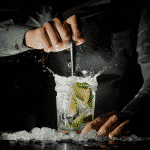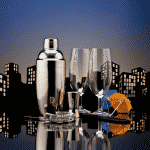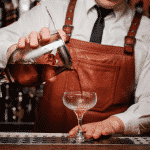Definition –
There are two legal classifications of London gin – ‘Gin’ and ‘Distilled Gin’. ‘Gin’ is a flavoured spirit with a minimum strength of 37.5% abv with the main flavour being juniper. A ‘Distilled Gin’ must be made by a process in which the juniper and other natural flavourings are distilled with the spirit in a pot still.
There is also an Appellation around Plymouth Gin in that it must be made in Plymouth.
Brief History–
Gin has a long and dark history starting in Italy in the 11th Century, when monks were flavouring distilled spirit with juniper.
The first recognizable ancestor of gin is credited to a Professor of medicine at Holland’s Leyden University called Dr. Sylvius.
British soldiers fighting in Holland during the 17th century found the spirit, which they called ‘Hollands’ and may have brought it home. It is the ‘Hollands’ that gained the nickname ‘Dutch Courage’ as it gave the English soldiers the heart and resolve to fight away from home. Its true English popularity came when William of Orange became King of England in 1689 (King William III). He declared war on the French and supported the war by banning all French imports, which included brandies and wines. With no Cognacs or wines, rums had not yet been established and whiskies being drunk only by the Scots and Irish, Genever (abbreviated to Gin) became the drink of choice. To re-enforce this, the government passed a law 1690 encouraging the distillation in England of brandy and spirits from corn. This meant that anybody could distil grain spirit for an extremely low tax. Hundreds of back-street distilleries sprung up with only a handful making good products. By the 1720s, London’s streets were awash with gin, much of it made with bad or poisonous ingredients and sold cheaply from street vendors. It was nicknamed ‘mother’s ruin’ as many addicted women neglected their children in favour of getting dosed up on gin. To tackle this problem, the government passed a series of laws from 1729 to restrict the sale and distillation of gin while encouraging beer production and sale. By the 1760s the situation was under relative control with the poorer classes back drinking beer in back-street taverns.
In 1825, the government again tried to free the trade in spirits. This time, to compete with beer taverns, the gin sellers opened up large, opulent establishments known as ‘Gin Palaces’. The hard liquor was a welcome change to the repressive factory conditions of the industrial revolution in England. Unfortunately, as before, entire families were getting drunk in these new venues so taxes were raised to make spirits expensive and beer cheap again.
Production–
There are several different ways of making Gin. In all these ways, the gin producer has to buy the neutral alcohol base from an outside supplier. If it is a grain spirit, it is usually from wheat or barley, however, the neutral spirit can come from any source.
Cold Compounding – This is the process used in making cheaper (supermarket) gins rather than distilled gins. A neutral spirit is used as a base to which oils and flavour essences are added to give the notes of juniper and other botanicals. The flavours are not ‘fixed’ into the spirit and are therefore lost very easily once the bottle is opened. This process makes a gin often referred to as ‘bath-tub’ gin.
Distilled Gin – The aim of making a gin is to extract the essence of the botanicals into the spirit and then reduce its abv with water before bottling. Different gin producers will use different botanical recipes and methods of infusion but they will use one of the following methods:
One-Shot Method – With the one-shot method, juniper and the other botanicals are macerated in the neutral spirit and water according to the distillers’ recipe. This maceration my go on for up to 48 hours. The botanicals are strained off and the spirit is poured into the still. The distillation occurs in a copper pot still. Some producers will distil with the botanicals in the still to further fix the flavours in the gin. Water is then added to the gin before bottling.
Two-Shot Method – This is a quicker method and saves on still usage (therefore more economically viable). In this method, a much stronger mix of botanicals is used in the maceration and distillation process. This is used as a concentrate and mixed with neutral spirit alcohol to increase the final volume. Water is then added to the gin before bottling. The main brand using this method today is Gordon’s Gin.
Vapour Infusion Method – With this technique, the botanicals are not macerated with the neutral spirit. They are placed in a basket or cage in the neck of the still. The alcohol vapours pass over them during distillation and pick up the flavours for the gin. The main brands using this method today is Bombay Sapphire and Hendricks (the Carterhead Still).
What is Old Tom?–
Old Tom Gin (or Tom Gin or Old Tom) is a lightly sweetened Gin popular in 18th-century England that now is rarely available. It is slightly sweeter than London Dry, but slightly drier than Dutch/Holland Gin/Jenever.
The name “Old Tom Gin” purportedly came from wooden plaques shaped like a black cat (an “Old Tom”) mounted on the outside wall of some pubs above a public walkway in the 1700s England. After a pedestrian deposited a penny in the cat’s mouth, they would place their lips around a small tube between the cat’s paws. From the tube would come a shot of Gin, poured there by the bartender inside the pub.
Old Tom Gin was formerly made under licence by a variety of distillers around the world; however one was recently relaunched by Hayman’s distillery based on an original recipe. The first written record of Old Tom Gin being used in the Tom Collins cocktail was the 1891 book, The Flowing Bowl: When and what to drink by William Schmidt .
Classic Cocktails
Martinez–
Original Recipe:
Bartender’s Guide by Jerry Thomas (1887)
(Use small bar-glass.)
- Take 1 dash of Boker’s bitters.
- 2 dashes of Maraschino.
- 1 pony of Old Tom gin.
- 1 wine-glass of Vermouth.
- 2 small lumps of ice.
Shake up thoroughly, and strain into a large cocktail glass. Put a quarter of a slice of lemon in the glass, and serve. If the guest prefers it very sweet, add two dashes of gum syrup.
[Note: A pony is an ounce; a wine-glass is about 4 ounces.]
Today’s Recipe:
The Joy of Mixology by Gary Regan (2003)
- 60ml gin
- 30ml sweet vermouth
- 5ml maraschino liqueur
- 2 dash Angostura bitters
Stir with ice, strain into a chilled cocktail glass. Garnish with a lemon twist.
Martini–
New & Improved Illustrated Bartender’s Manual by Harry Johnson (1888)
Original Recipe-
- 2 dashes of Gomme syrup
- 2 dashes of Boker’s bitters
- 1 dash of curaçao
- 60ml Old Tom gin
- 60ml dry vermouth
Stir with ice and strain into a cocktail glass. Garnish with a cherry, olive or lemon twist.
Modern Recipe-
The Joy of Mixology by Gary Regan (2003)
- 75ml Gin
- 15ml Dry vermouth
Stir and strain into a chilled cocktail glass. Garnish with an olive or lemon twist.
Tom Collins
Original Recipe-
The Bartenders Guide by Jerry Thomas (1876)
- 5 dashes of gum syrup
- Juice of a small lemon
- 1 large wine glass of gin
Shake and strain into a large bar glass. Add 2 or 3 lumps of ice and top with soda water.
Modern Recipe-
Vintage Spirits and Forgotten Cocktails by Ted Haigh (2004)
- 60ml gin
- 30ml lemon juice
- 30ml simple syrup
Shake and strain into a Collins glass. Add ice. Top with soda. Garnish with a lemon wedge and a cherry.
Ramos Gin Fizz-
- 50ml gin
- 25ml lemon juice
- 20ml simple syrup
- 2 dashes of orange blossom water
- 20ml double cream
- 1 egg white
Shake all ingredients with ice until you can no longer hear the ice, then pour all contents of the tin into a Collins glass and top with soda so the head rises above the rim of the glass. The straw should be able to stand upright without touching the glass.
Now go be better with your new knowledge of wonderful wonderful gin.










argentumvulgaris
Reblogged this on Things that Fizz & Stuff.